Oa (3.5e Campaign Setting)
| This is complete in many aspects, but information is sparse in a few categories. Please help improve this.
What are the rating guidelines in more detail? |
(This is a work in progress. Please allow some time for completion.)
Oa
Oa (Ohw-uh)is a home brew campaign setting that is intended to be built-upon by Dungeon Masters to use as a blank slate. The amount of open land in this setting is present to accommodate this need. The playable races are kept to a bare minimum to allow for simplicity and to avoid over-crowding the campaign from the start with too many options. It is important to note that nationality plays a large role in Oa as different nations possess different policies in terms of health, culture, and justice. Oa is intended to simulate an entire world, with room to spare. If you feel like using this setting, feel free to do so, and please do not hesitate to add to it, so long as your alteration resides within the confines of your own campaign.
Project Goal
The primary goal of this project is to create a simple, easy-to-understand, and accessible Campaign Setting that is not only stable and in-depth, but has room for the Dungeon Master to add to it as he or she pleases without worrying about over-crowding the map.
World Map
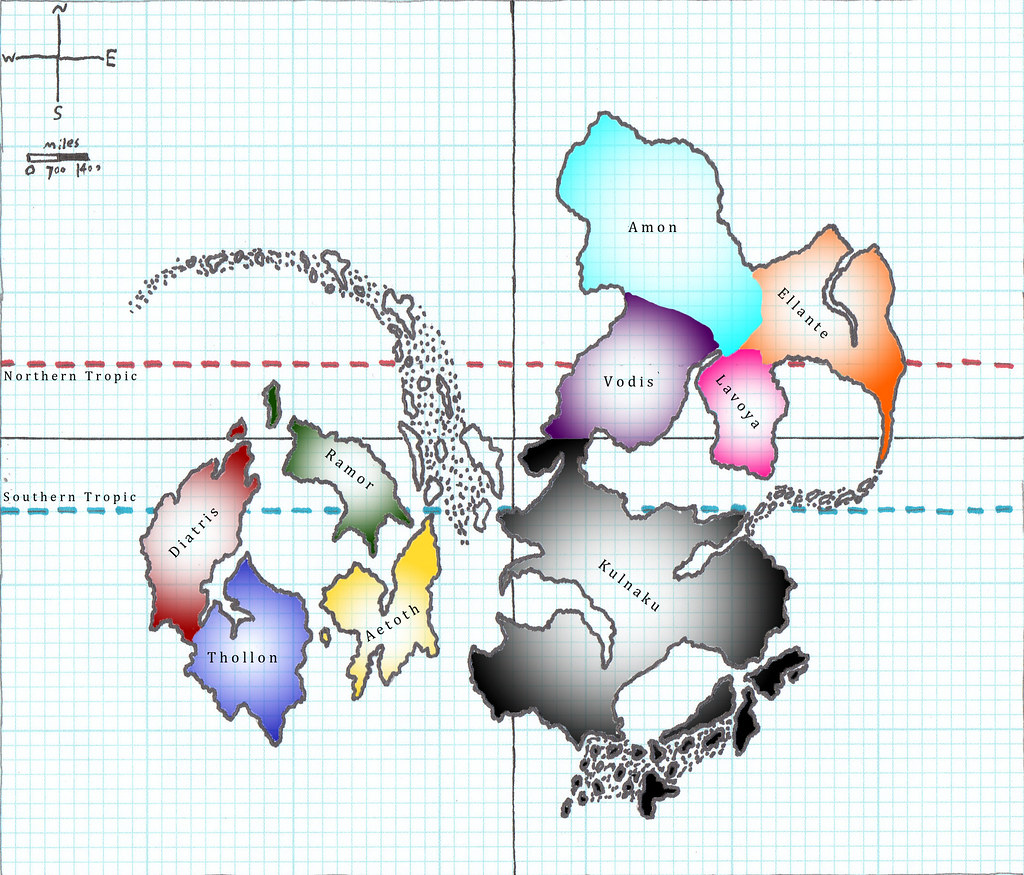
Planetary Data
- Equatorial Circumference: ~24,500 Miles (~39428.928 Kilometers)
- Radius: ~3,899.3 Miles (~6275.3 Kilometers)
- Acceleration due to Gravity: 32.1522 feet/(s^2) (9.8 m/(s^2)) NOTE: While the actual acceleration due to gravity
would be equal to 10.12 m/(s^2) for convenience sake it is advised to just use earth's gravitational acceleration
so as to maintain the consistency of the calculated battle tables. - Distance from Sun: 1 AU
- Rotational period: ~24 hours
- Revolutionary period: 365.25 days
- Area of Tropical Region: ~85,750,000 square miles
Races
There are many races that live in Oa, the most populous of which being the Dark Elves, but unlike in other worlds, the races live in heterogeneously composed nations. Meaning no one nation is host to just one race of people for permanent residence.
Demography

- Drow: 1,875,147,000
- Dwarves: 650,565,300
- Elves: 219,525,000
- Gnomes: 140,525,000
- Half-Elf: 46,035,000
- Half-Orcs: 7,110,000
- Halfling: 105,725,000
- Human: 181,180,000
Playable Races
Other races can be played with DM consent but please note that their presence will be extraordinarily rare (as in .00000001% of the population) and will have to be incorporated into their character's story. It is inadvisable to play a character race that is not on this list and to not explain it whatsoever as it will most likely damage the campaign setting as a whole.
Predominant Races
These are races that are populous enough to be declared significant to Oa's balance of power. They are all added together into the group titled as "Other" excluding the playable races.
- Aberration
- Centaur
- Demon
- Devil
- Dragon
- Drow
- Dryad
- Dwarves
- Elves
- Gnomes
- Goblinoid
- Grig
- Half-Elf
- Half-Orcs
- Halflings
- Human
- Nymph
- Orc
- Satyr
- SRD:Lizardfolk (Race)
Oa Specific Creatures
The Fey
The Fey of Oa are governed by the three original fey races: Fairy, Nixie, and Pixie. In the beginning, the Goddess Ehlonna made the fairies to protect and preserve nature. But the fairies couldn't agree on how best to do so and over time they began to drift apart and compete with each other for Ehlonna's attention. When it became apparent that the pixies would never win over Ehlonna's favor with their mischievous and menacing ways, they began to pervert nature and create the dire beasts to harass the mortals and the other forest-dwelling creatures. The Nixies, too concerned with balance to interfere decided that it was the natural flow of equilibrium for this to happen and did nothing whereas the Fairies began to make alliances with the elves that have lasted for thousands of years since as the two races struggle to protect the forests and the rest of the world from the evil of the pixies.
However, all Fey enjoy a bit of mischief and physical comedy whether they'll admit it or not. It's just that the Pixies tend to take the jokes and mischief much, much farther than most other fey so much so that others might see their humor as morbid and deranged sometimes.
The complicating factor is, there is no visual way to tell the difference between Fairies, Nixies, or Pixies. They all have butterfly wings, look humanoid, and are roughly the same size. Pixies love to use this to their advantage and usually pose as Fairies or Nixies to gain the trust of an unwary victim.
Fairies
| Fairy | |
|---|---|
| Size/Type: | Fine Fey (Good) |
| Hit Dice: | 2d6 (7 hp) |
| Initiative: | +12 |
| Speed: | 5 ft. (1 squares), fly (perfect) 60 ft. |
| Armor Class: | 26 (+8 size, +8 Dex), touch 18, flat-footed 18 |
| Base Attack/Grapple: | +1/–16 |
| Attack: | — |
| Full Attack: | — |
| Space/Reach: | {{{space}}}/{{{reach}}} |
| Special Attacks: | — |
| Special Qualities: | Amphibious, damage reduction 5/cold iron, low-light vision, spell resistance 16, wild empathy |
| Saves: | Fort +1, Ref +10, Will +5 |
| Abilities: | Str 1, Dex 26, Con 10, Int 18, Wis 16, Cha 14 |
| Skills: | 50 Skill Points |
| Feats: | — |
| Environment: | Any Forest, Any Marsh |
| Organization: | Gang (2–4), band (6–11), or tribe (20–80) |
| Challenge Rating: | 1 |
| Treasure: | No coins; 50% goods (metal or stone only); 50% items (no scrolls) |
| Alignment: | Usually neutral good |
| Advancement: | 3–4 HD (Fine) |
| Level Adjustment: | +3 |
Fairies generally live anywhere where there is an abundance of life, though they tend to prefer forests over marshlands. Generally, Fairies prefer to use magic and innovation to meet their ends and are known for their elaborate, yet tiny, cities built into trees and anywhere they like.
Nixies
| Nixie | |
|---|---|
| Size/Type: | Fine Fey (Neutral) |
| Hit Dice: | 2d6 (7 hp) |
| Initiative: | +12 |
| Speed: | 5 ft. (1 squares), fly (perfect) 60 ft. |
| Armor Class: | 26 (+8 size, +8 Dex), touch 18, flat-footed 18 |
| Base Attack/Grapple: | +1/–16 |
| Attack: | — |
| Full Attack: | — |
| Space/Reach: | {{{space}}}/{{{reach}}} |
| Special Attacks: | — |
| Special Qualities: | Amphibious, damage reduction 5/cold iron, low-light vision, spell resistance 16, wild empathy |
| Saves: | Fort +1, Ref +10, Will +6 |
| Abilities: | Str 1, Dex 26, Con 10, Int 16, Wis 18, Cha 14 |
| Skills: | 45 Skill Points |
| Feats: | — |
| Environment: | Any Forest, Any Marsh |
| Organization: | Gang (2–4), band (6–11), or tribe (20–80) |
| Challenge Rating: | 1 |
| Treasure: | No coins; 50% goods (metal or stone only); 50% items (no scrolls) |
| Alignment: | Usually neutral |
| Advancement: | 3–4 HD (Fine) |
| Level Adjustment: | +3 |
Nixies are the self-appointed guardians of all things natural. They protect endangered species, ward off hunters from infant creatures, and do everything in their power to protect nature. But they are also obsessed with neutrality and carefully weigh their options before taking action.
Pixies
| Pixie | |
|---|---|
| Size/Type: | Fine Fey (Evil) |
| Hit Dice: | 2d6 (7 hp) |
| Initiative: | +12 |
| Speed: | 5 ft. (1 squares), fly (perfect) 60 ft. |
| Armor Class: | 26 (+8 size, +8 Dex), touch 18, flat-footed 18 |
| Base Attack/Grapple: | +1/–16 |
| Attack: | — |
| Full Attack: | — |
| Space/Reach: | {{{space}}}/{{{reach}}} |
| Special Attacks: | — |
| Special Qualities: | Amphibious, damage reduction 5/cold iron, low-light vision, spell resistance 16, wild empathy |
| Saves: | Fort +1, Ref +10, Will +5 |
| Abilities: | Str 1, Dex 26, Con 10, Int 14, Wis 16, Cha 18 |
| Skills: | 40 Skill Points |
| Feats: | — |
| Environment: | Any Forest, Any Marsh |
| Organization: | Gang (2–4), band (6–11), or tribe (20–80) |
| Challenge Rating: | 1 |
| Treasure: | No coins; 50% goods (metal or stone only); 50% items (no scrolls) |
| Alignment: | Usually neutral |
| Advancement: | 3–4 HD (Fine) |
| Level Adjustment: | +3 |
Pixies are black-hearted Fey that are infamous for stealing children and mutating them into abominations of nature. Which is supposed to be their idea of a joke at Ehlonna's expense. They typically make animals into Dire animals and use them to harass others for a good laugh. Pixies are devious tricksters and love to fool mortals into miserable agreements.
Classes
Core D&D 3.5e classes only unless the DM says otherwise. Psionic classes and abilities are NOT PERMITTED by default unless the DM says otherwise. The classes are categorized based on their commonality.
Rare: ~1 per 500,000 people
These classes are rare and characters almost never encounter these kinds of people regardless of circumstances.
Uncommon: ~1 per 100,000 people
These classes are uncommon and characters usually don't encounter these kinds of people under common circumstances.
Common: ~1 per 50,000 people
These classes are common and characters frequently run into people with these qualifications.
Choosing a Class
To keep with the commonality of the classes, it is possible to select your class by rolling a percentile die (d100) and comparing the result to this table.
| Rare: | 94-100 |
|---|---|
| Uncommon: | 63-93 |
| Common: | 0-62 |
Social Class
Your character has a family, they were born someplace. To reflect this, there are Socio-Economic tables that one may use to roll 1d100 for your character's social class. Social class determines things like bonus skill points, starting money, and so on.
Note:
The table is read from left to right with the sub-category of class being the first adjective in the socio-economic class name. For instance, if you roll a 50 on a 1d100 roll for this table then the result would be "Upper-Lower Class". This is because the adjective in the result's corresponding row is "Upper" and the adjective in the result's corresponding column is "Lower".
| Lower: (60%) | Middle: (30%) | Upper: (10%) | |
|---|---|---|---|
| Lower: | 1-10 | 61-80 | 91-95 |
| Middle: | 11-40 | 81-85 | 96-98 |
| Upper: | 41-60 | 86-90 | 99-100 |
Social Class Rewards
Here is the information that corresponds to what your character is entitled to based on their social class.
| Sub-Class: | Starting Money: | Skill Bonuses: | Property: | Salary: | Taxes: |
|---|---|---|---|---|---|
| Lower: | 1d8 gp | Hide +1d4, Move Silently +1d4, Sleight of Hand +1d4 | Home: None, Land: None, Transportation: None | +0d4 gp / Week | -0% net worth/ Year |
| Middle: | 2d8 gp | Profession +1d6, Knowledge of Profession +1d6 | Home: Shack, Land: None, Transportation: None | +1d4 gp / Week | -50% net worth/ Year |
| Upper: | 3d8 gp | Profession +1d8, Knowledge of Profession +1d8 | Home: Hut, Land: None, Transportation: None | +2d4 gp / Week | -25% net worth/ Year |
| Sub-Class: | Starting Money: | Skill Bonuses: | Property: | Salary: | Taxes: |
|---|---|---|---|---|---|
| Lower: | 4d10 gp | Profession +1d8, Knowledge of Profession +1d8, Knowledge any +1d4, Craft +1d4 | Home: Cottage, Land: small plot of land (< 1 acre), Transportation: none | +2d10 gp / Week | -15% net worth/ Year |
| Middle: | 5d10 gp | Profession +1d8, Knowledge of Profession +1d8, Knowledge any +1d6, Craft +1d6 | Home: House, Land: medium plot of land (1-2 acres), Transportation: Cart with donkey | +4d10 gp / Week | -10% net worth/ Year |
| Upper: | 6d10 gp | Profession +1d8, Knowledge of Profession +1d8, Knowledge any +1d8, Craft +1d8 | Home: Hall, Land: large plot of land (3-4 acres), Transportation: Cart with donkey, Horses | +6d10 gp / Week | - 5% net worth/ Year |
| Sub-Class: | Starting Money: | Skill Bonuses: | Property: | Tributary Income: |
|---|---|---|---|---|
| Lower: | 7d100 gp | Knowledge of Nobility +1d4, Speak Language +1d4, Ride +1d4, 5 extra skill points at first level | Home: Manor, Land: City, Transportation: Horses | +2d100 gp / Month |
| Middle: | 8d100 gp | Knowledge of Nobility +1d6, Speak Language +1d6, Ride +1d6, 10 extra skill points at first level | Home: Castle, Land: Provence, Transportation: Horses, Carraige | +4d100 gp / Month |
| Upper: | 9d100 gp | Knowledge of Nobility +1d8 Speak Language +1d8, Ride +1d8, 15 extra skill points at first level | Home: Palace, Land: Nation, Transportation: Horses, Carriage, Yacht | +6d100 gp / Month |
Currency
| Equivalency | Copper Pieces (CP) | Silver Pieces (SP) | Gold Pieces (GP) | Platinum Pieces (PP) |
|---|---|---|---|---|
| CP | 1 | .1 | .01 | .001 |
| SP | 10 | 1 | .1 | .01 |
| GP | 100 | 10 | 1 | .1 |
| PP | 1000 | 100 | 10 | 1 |
| Equivalency | 1 CP | 1 SP | 1 GP | 1 PP |
|---|---|---|---|---|
| In U.S. Dollars | $0.1 | $1 | $10 | $100 |
| In E.U. Euros | €.075 | €.75 | €7.57 | €75.75 |
Technology Level
Time Period:
- Late medieval, early-renaissance
- Comparable to 1300 AD -1400 AD
Health and Sanitation:
- Diseases are called plagues and are dealt with on a varying basis from nation to nation.
- Mental disorders are commonly mistaken for demon-possessions.
- Vodis, Diatris, Ellante, Lavoya, and Kulnaku have building codes that include plumbing and bathrooms. The other four nations do not have this policy.
Warfare:
- Medieval weaponry are predominantly used.
- Handguns and rifles do not exist but may be invented by someone intelligent enough to figure it out.
- Warships have large and bulky cannons.
Transportation:
- Animal-drawn carts or carriages are mostly used.
- All core D&D ship types are cannon in Oa. Though the design of the ships varies from nation to nation depending on how advanced they are.
Research:
- Research and academic study varies from nation to nation.
- The most famous nation for academia, whether it be in magic, technology, or otherwise, is Ellante.
- Most other nations, besides Ellante, use a guild and skilled labor system with independent researchers.
Magic Level
- ~15% of the population of OA is capable of using arcane magic. Not to be confused with the commonality of classes.
- ~10% of the population of OA is capable of using divine magic. Not to be confused with the commonality of classes.
- Magic is accepted and used on a varying basis from nation to nation. Some nations rely on magic more commonly than others. Some hardly use magic at all, if ever.
Magical Items
To make magic more special and exotic. It has been decided that along with magical classes, that magical items will also be made more rare than usual.
What this means is, if the DM is trying to determine if something is magical or not, then they must roll a percentile die. The probability of something, whatever it may be, possessing Magical properties, is 3%.
Potions, however, are more common. Liquids found in bottles have a 20% chance of being magical.
Detect Magic
Because magic is so uncommon in Oa, those who are attuned to it are extra sensitive to its presence. This means that the spell Detect Magic can be used as an at-will spell-like ability by Wizards, Sorcerers, Clerics, Paladins, Bards, and Druids. However it does not determine where the magic is, just whether or not something focused on by the user is magical or not. Presence is detected, not location or positioning.
Deities
- Note: this section is bound to change dramatically in the near future!*
The Deities in this campaign setting are immortal, indestructible, and invulnerable. It is irrelevant if a deity has stats in a published book, by default the deities are invincible in this campaign setting. They do not ever appear on the mortal plain of existence and have never needed to before. None of them are cited in being responsible for creation of Oa, they are instead said to have made contact with the realm of Oa as outsiders hundreds of thousands of years ago. Outsiders are fabulously rare, perhaps considering Oa as a destination in once every ten thousand years, however there are still pocket settlements made 'closer' to Oa than to other places but even they are considered significantly remote relatively speaking. Oa is meant to be a standard campaign setting with as little confusing theology and lore as possible. Therefore the list of deities for this realm is static, they cannot die, and new deities do not enter the mix. If other settings are to be bridged to this setting, then Oa is seen as minor protectorate in terms of priorities for the deities regardless of alignment. In terms of spiritual resources and motivation, Oa is considered a far off dimension not worth taking the trouble to travel all the way to in order to warrant sustained attention. The deities may help out the most devout of their worshipers in Oa, but few else.
| Lawful Good | Neutral Good | Chaotic Good | Lawful Neutral | True Neutral | Chaotic Neutral | Lawful Evil | Neutral Evil | Chaotic Evil | |
|---|---|---|---|---|---|---|---|---|---|
| Major Deity | Moradin | Pelor | Corellon Larethian | Garl Glittergold | Boccob | Yondalla | Wee Jas | Nerull | Gruumsh |
| Minor Deity | Heironeous | Ehlonna | Kord | Saint Cuthbert | Obad-Hai | Olidammara | Hextor | N/A | Erythnul |
| Avatar | Heironeous | N/A | N/A | Saint Cuthbert | N/A | N/A | Hextor | Vecna | N/A |
In general, divine power is not very present in Oa's history. What is much more present is fundamentalist interpretation of the use of divine power. Generally Clerics and Paladins who act in the spirit of their chosen deity (Diatris included) receive divine assistance. However, it is commonly rumored that high priests tend not to use their power only because they have broken alignment and no longer have it, but such talk is commonly cast down as mere rumors.
Travel and Scale
Oa is a very large world. This is by design as its amount of space is intended to provide a tabula rasa for DM's looking for a place to put their dungeon and campaign ideas. That being said, travel on Oa takes a while as the distances between most major cities is quite significant.
| Method: | Travel Distance (miles): | Travel Range (days) | Miles per day: | Encounter Chance: |
|---|---|---|---|---|
| Walking | 1d300 | 15 | 20 | 10% |
| Light horse/mount | 2d300 | 20 | 30 | 20% |
| Heavy horse/mount | 3d300 | 18 | 50 | 30% |
| Carriage/Cart (roads only) | 4d300 | 20 | 60 | 40% |
| Sailboat (small) | 2d300 | 6 | 110 | 20% |
| Sailboat (large) | 4d300 | 12 | 100 | 40% |
| Ship | 8d300 | 20 | 120 | 80% |
Range
The range of each means of transportation determines how many days can elapse before the rations for that method's number of d300 run out. It is possible to prepare extra rations in advance and it is also possible to go hunting or fishing to acquire more food.
Encounters
At the end of the distance determined by the travel method's range (i.e. 1d300 etc.), a mandatory random encounter occurs. It need not be combat, but it can be.
Encounters can occur within the rolled travel distance if the DM rolls 1d100 for every 300 miles that the party travels. If the DM rolls higher than the encounter chance, then nothing occurs. If the DM rolls lower than the encounter chance, then a random encounter happens. This is based on how high of a profile the travel method is in terms of how noticeable and bulky it may be.
The reason for encounter chances is to make the presence of monsters and special circumstances more special and to stick out more on the party's journey. If monsters are constantly attacking every single day for every ten miles that the party travels, then they will quickly lose their luster and it would beg the question: If monsters are such a frequent problem on the roads of this nation then how does the nation's economy function?
Alternative Travel Methods
For any other means of travel that is not on the table above. Have the DM assign however many d300 that they deem appropriate and research how fast the means of travel is in terms of miles per hour. That should help in assigning travel speeds.
Combat in Oa
The Dungeon Master can choose to use these sets of rules while using the Oa Campaign Setting. They are entirely optional.
Combat States
These are alternative definitions of some of the many states in combat.
| State: | Definition: | Effect: |
|---|---|---|
| Flanking | Attacker is attacking its target from the target's side. 90 degrees from the target's facing position. | +2 To attack rolls. |
| Back-Attacking | Attacker is attacking its target from the target's rear position. 180 degrees from the target's facing position. | +4 to attack rolls. |
| Prone | Subject has most of its body on or very close to the ground. | -4 to AC against melee attacks +4 to AC against ranged attacks -4 to melee attacks +4 to ranged attacks -50% to movement speed +4 to Hide and Move Silently checks. |
| Crouching | Subject has lowered their torso closer to the ground and has both knees bent to do so. | -2 to AC against melee attacks +2 to AC against ranged attacks -2 to melee attacks +2 to ranged attacks -25% to movement speed +2 to Hide and Move Silently checks. |
Sentry Mode
This is a homebrew combat state that refers to a character using a standard action to set themselves up in anticipation for an attack. Unlike Fighting Defensively , Sentry Mode refers to a more active means of a defense. Meaning that the character in sentry mode will instantly attack anything hostile that comes within a threatened square of theirs, counting that attack as an attack of opportunity. Moving after going into sentry mode deactivates it.
| Type: | At-will |
|---|---|
| Preparation: | Standard Action |
| Duration: | Until Deactivated |
| Effect: | Enemy movement, of any type, into or through a threatened square of the subject in sentry mode provokes an attack of opportunity. |
Called Shots
A player and/or an NPC can make a specifically targeted attack against their enemy. The effect of successfully hitting them is concentrated damage on a specific area of the target. However this action of targeting a specific part of an enemy makes the user of the called shot suffer a penalty.
Mechanically what this means is that making a called shot applies a -4 penalty to the attack roll. If the attack roll hits the target AC, then the damage roll is an instant critical hit.
Targets and Effects
You can specify a target on an opponent that is not listed here. If so then it becomes the DM's decision as to the effects of landing a successful called shot to that particular target.
| Body Part: | Result: |
|---|---|
| Head | 1d10 bleeding damage per turn until healed. DC = 20 |
| Neck | 2d10 bleeding damage per turn until healed. DC = 30 |
| Heart | 4d12 bleeding damage per turn until healed. DC = 50 |
| Spine | Everything below the targeted area is paralyzed. |
| Arm (Outer) | Crippled |
| Arm (Inner) | 2d10 bleeding damage per turn until healed. DC = 30 |
| Leg (Outer) | Crippled |
| Leg (Inner) | 2d10 bleeding damage per turn until healed. DC = 30 |
| Groin | Target is stunned and falls prone for 1d4 turns. |
Feats and Penalties
Certain feats may instead apply to called shot penalties.
| Feat: | Effect: |
|---|---|
| None | -4 penalty for each attack roll that is a called shot. Critical weapon damage. |
| Precise Shot | -2 penalty for each attack roll made with a ranged weapon that the character is proficient with. Critical weapon damage. |
| Improved Precise Shot | No penalty to each attack roll made with a ranged weapon that the character is proficient with. Critical weapon damage. |
Immunities
If the target is immune to critical hits then the called shot has no effect on the damage roll.
Healing
Healing works slightly differently in Oa. Anyone with at least 1 rank in the Heal skill is capable of making a heal check. The result of that check is as follows:
| Heal Check: | Result: |
|---|---|
| 1-20 | Stabalized |
| 22-30 | Heal 1d6 HP per 2 points above 20 |
| 32-40 | Heal 1d8 HP per 2 points above 30 |
| 42-50 | Heal 1d10 HP per 2 points above 40 |
| 52-60 | Heal 1d12 HP per 2 points above 50 |
| 60+ | Heal 1d20 HP per 2 points above 60 |
| Natrual 20 | Heal subject back to full health as long as they are not dead. |
| Natrual 1 | If the subject is dying then they instantly die but get only one fortitude saving throw of DC 20 to make a recovery.
If the subject is not dying then they start dying at 0 HP. |
Rounding Policy
If the resultant heal check is an odd number, then round up when determining the number of die to heal.
Time Taken
Doing a heal check takes at least 10 minutes per / 5 HP restored.
Counting Healed HP
Totaling up the amount of healed HP is a matter of determining the value of the heal check first, then adding together the total number of healing die by their respective brackets.
Example:
- Step 1.) A 40 is rolled on a heal check. (1d20 + Heal + Wisdom Modifier + Misc Bonus)
- Step 2.) For every 2 points above twenty but under thirty that the check resulted in. Heal 1d6. That means roll 5d6 for healing. (Roll 5d6)
- Step 3.) For every 2 points above thirty but under forty that the check resulted in. Heal 1d8. That means roll 5d8 for healing. (Roll 5d8)
- Step 4.) Add together the results of 5d6 and 5d8 to determine the total number of HP healed. (5d6+5d8)
- Step 5.) Divide the total amount of HP healed by 5 to determine the time it took to execute the heal check. ([5d6+5d8]/5)
Nationalities
There are nine different nations in the world of Oa. Each possessing a heterogeneous population. Culture, Creed, and government vary widely between nations. Eight of the nine nations are not categorizable with a single alignment, as there is too much variation amid the population to make a judgement on that. However, it is widely agreed that just about everyone and everything that inhabits Kulnaku is mostly evil. This means that if your character is any sort of evil, and they are drow, then it is very likely that they either were born in Kulnaku and live there now, or came from there whether as a refugee or by lineage.
National Attributes
In Oa, nationality plays a large role in terms of defining who a character is and what their upbringing was like. It doesn't mandate alignment but it can have an effect on that. Here is a list of the mechanical adjustments made according to a character's nationality. These attributes apply to a character that grew up as a native of these nations. Not to people who grew up in numerous nations over time.
| Skill Bonuses | Main Language | Accent | Garb | Combat style | |
|---|---|---|---|---|---|
| Aetoth | Profession +1d2 Ride +1d20 Knowledge:History +1d4 Gather Information +1d2 |
Common | Similar to Australian | Practical and durable. Similar to Turkish. |
Mostly concerned with cavalry tactics. Tend to prefer to limit the enemy's movement as much as possible. |
| Amon | Knowledge Nature +1d4 Knowledge History +1d10 Heal +1d10 Knowledge Arcana +1d2 Use Magical Device +1d2 |
Elven | Similar to Arabic | Simple but comfortable. Similar to Pre-Meji Japanese. |
Methodical and precise. |
| Diatris | Craft Blacksmith +1d2 Knowledge Religion +1d20 Knowledge War +1d6 |
Celestial | Similar to Italian and Spanish | Lots of red and gold and black. Similar to ancient Roman. |
Variable and unpredictable, but devastating and effective. |
| Ellante | Knowledge Arcana +1d20 Knowledge History +1d20 Spellcraft +1d10 Use Magical Device +1d8 |
Gnome Halfling |
Similar to Latin | Baggy and comfortable. Similar to Han Dynasty Chinese. |
Complex and confusing yet precise and organized. |
| Kulnaku | Knowledge History +1d2 Hide +1d2 Move Silently +1d2 Sleight of Hand +1d2 Open Lock +1d2 Knowledge Monsters +1d10 Bluff +1d10 |
Drow Drow Silent |
Similar to Japanese and Chinese | Elegant and terrifying. Similar to Victorian English. |
Guerrilla and stealth based. Prefer to flee to a strong point and lure enemies into a trap than direct confrontation. |
| Lavoya | Diplomacy +1d10 Bluff +1d10 Profession Merchant +1d4 Perform +1d4 |
Common | Similar to French | Ornate and stylish. Similar to Venetian. |
Tend towards diplomacy and traditional tactics and stratagems. |
| Ramor | Knowledge Nature +1d20 Knowledge Geography +1d8 |
Common | Similar to American (Southern) | Breathable and comfortable. Similar to Pre-Exploration South American clothing. |
Dependent on home-field advantage mostly with troops being thoroughly briefed beforehand. Tactics vary widely. |
| Thollon | Swim +1d8 Profession +1d4 Craft +1d4 Gather Information +1d2 Spot +1d2 Search +1d4 |
Common | Similar to British | Modest and durable. Similar to medieval English. |
Direct and confrontational. |
| Vodis | Knowledge War +1d6 Craft +1d12 Knowledge Engineering and Architecture +1d6 |
Dwarven | Similar to German and Scottish | Practical and Durable with geometric patterns and designs. Similar to Viking. |
Highly organized and practiced, often relying on brute strength and strong points rather than rapid movement. |
Knowledge Local
All players get to roll 1d20 for their Knowledge local national bonus pertaining to the nation that they were born and raised in, or merely spent most of their life in.
Aetoth
- (Eh-ta-th)
- adj: Aetothan
The ethnic dumping ground of Thollon and Diatris. Aetoth was founded by "undesireables" who were deported from neighboring kingdoms to free up jobs for humans. Half-breeds and roudy elves were arrested and shipped to the continent of Aetoth to forage for themselves. Currently they are treated with high regard by the Elves, Gnomes, and to some small degree the Dwarves as Aetoth provides a very nice foot-hold position on Kulnaku, should an invasion ever prove necessary again.
National Flag
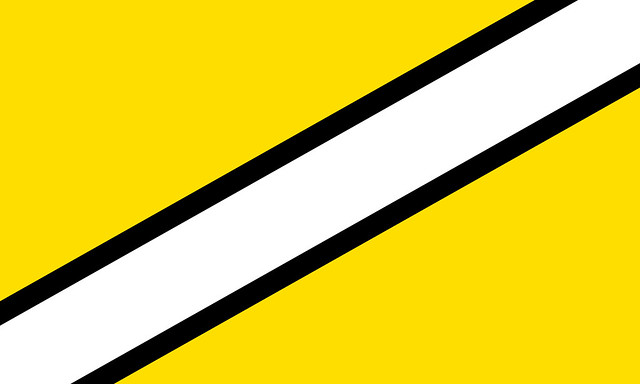
National Map
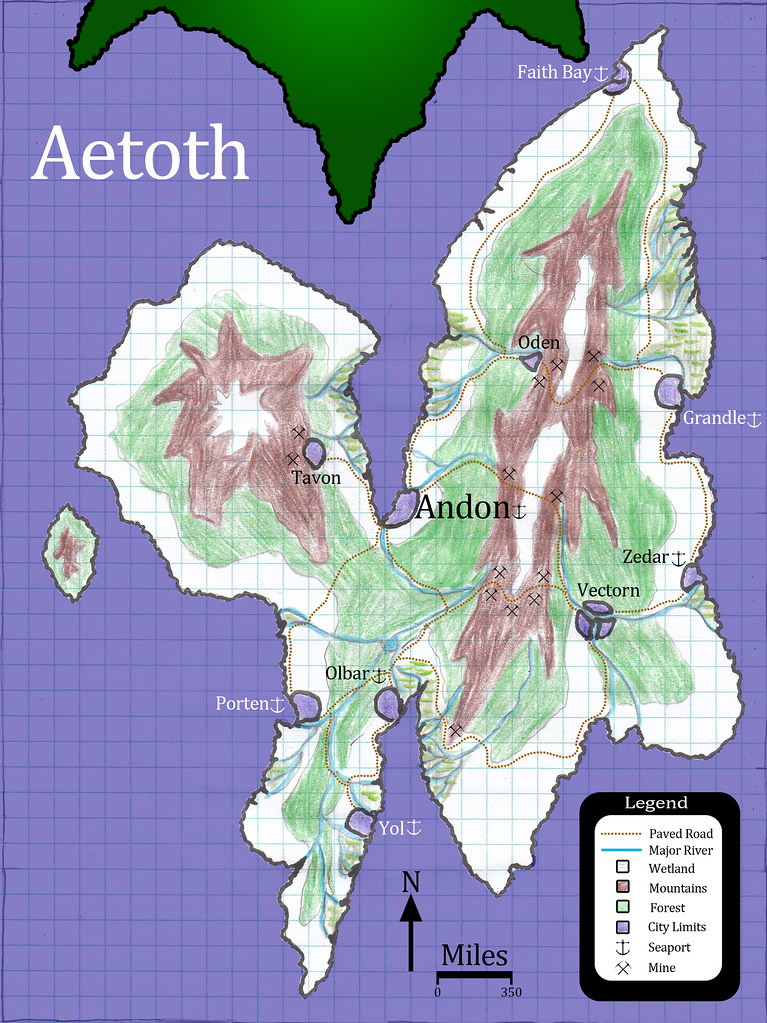
Demography
- Population: ~23,500,000
- 40% Half-Elf
- 20% Elf
- 15% Halfling
- 10% Human
- 8% Half-Orc
- 5% Gnome
- 1.98% Dwarf
- .2% Drow Refugees/ escapees from Kulnaku
Leadership
- Government: Representative Democracy
- Leadership: Grand Council (panel of 5 executors)
- Power acquisition: Election (popular vote)
Relations
- Amon: Allies, major trading partners
- Diatris: Enemies
- Ellante: Friends, trading partners
- Kulnaku: Enemies
- Lavoya: Allies, major trading partners
- Ramor: Friends, trading partners
- Thollon: Neutral
- Vodis: Neutral, sparse official trade
Economy
- Income:
- Sea-based trade: 60%
- Land-based trade: 2%
- Taxation: 35%
- Banking and Investment: 3%
- Expenses:
- Military: -20%
- Research: -15%
- Public Works: -45%
- Salaries: -20%
Military
- Equipment:
- Melee-Weapon of Choice: Scimitar (if uses shield), Falchion (if does not use shield)
- Ranged-Weapon of Choice: Compound Longbow
- Light Armor of choice: Studded Leather
- Heavy Armor of choice: Half-plate
- Shield of choice: Tower Shield
- Uniform: A golden-yellow sash strung over the left shoulder and wrapped around the right hip.
- Numbers (Standing):
- Infantry (light): 50,000 soldiers
- Infantry (heavy): 25,000 soldiers
- Cavalry (light): 20,000 soldiers
- Cavalry (heavy): 17,000 soldiers
- Navy (light): 20 ships, 5,000 sailors
- Navy (heavy): 17 ships, 3,250 sailors
- Special Forces: 300,000 operatives
- Intellegence: 1700 soldiers
- Espionage: 23,000 agents, 1500 analysts
- Leadership: 25,000 officers
- Numbers (potential draftees)
- N/A (Aetoth does not have a draft.)
Religion
- No state religion
- Mostly Elven Deities are worshipped due to the majority of the population being either Half-elf or elf.
Culture
- Women's Rights: Women possess the right to vote in elections, can work and be paid money to own on their own, and can serve in the military. However, their rights have yet to extend to the point that they are allowed to serve as heads of state.
- Slave-labor: Prohibited.
- Magic: Magic is commonly used and accepted. Most people know at least some magic and use it daily.
- Education: In each major city, there are academies that only someone who passes the test may enter. The adademies are selective and few get it, but those who do, no matter how rich they are, usually do very well in life.
- Legal: Laws are enacted by the Grand Council after being submitted by the public.
Health
- Infant mortality rate: 35%
- Dental health: Poor, uncommonly worried about.
- Plague control: Depends on the particular plague.
Amon
- (Eh-mahn)
- (adj: Amonese)
The homeland of all elves on Oa, Amon is the pinnacle of magical civilization. While mostly hosting elves and half elves, all races are welcome here as the Amonese prefer to live in peace and harmony rather than bicker over trades and contest in combat. Having said this, they are not a feeble people and can be a terrible force to be reckoned with if provoked or threatened. They tend to live in settlements that do as little damage to the environment around them as possible and prefer studying magic and philosophy to other, more rambunctious activities.
National Flag

National Map
Demography
- Population: ~250,000,000
- 75% Elf
- 10% Half-Elf
- 5% Gnome
- 3% Fey
- 2% Other
Leadership
- Government: Hereditary Biarchy
- Monarch: Queen Raevala & King Tyo
- Heirs Apparent: Prince Rao & Princess Sylmae
Relations
- Aetoth: Allies, seen as brethren
- Diatris: Neutral, held in disdain
- Ellante: Allies, major trading partners
- Kulnaku: Enemies
- Lavoya: Allies, major trading partners
- Ramor: Allies, seen as brethren
- Thollon: Neutral, sparse independent trade
- Vodis: Neutral, major trading partners
Economy
- Income:
- Sea-based trade: 45%
- Land-based trade: 45%
- Taxation: 5%
- Banking and Investment: 5%
- Expenses:
- Military: -45%
- Research: -45
- Public Works: -5%
- Salaries: -5%
Military
- Children are selected at a young age to enlist in the military based on their personalities and physical prowess.
- Equipment:
- Melee-Weapon of Choice: Elvish Longsword
- +4 vs. AC, 1d8+4, slashing, medium, 18-20 x2, 3.25 lbs., 4000 gp
- Ranged-Weapon of Choice: Elvish Composite Longbow
- +4 vs. AC, 1d8+4, piercing, medium, x3, 2.25 lbs., 4000 gp
- Armor of choice: Elvish Armor
- +7 AC, 20 lbs., Dex Bonus: +4, Check Penalty: -3, Spell Failure = 25%, Hardness: 15, 35 HP, 2000 gp
- Shield of choice: Elvish Tower Shield
- +6 AC, 44.25 lbs., Dex Bonus: +3, Check Penalty: -9, Spell Failure = 50%, Hardness: 15, 70 HP, 2000 gp
- Uniform: A Cyan sash
- Melee-Weapon of Choice: Elvish Longsword
- Numbers (Standing):
- Infantry (light): 5,000,000
- Infantry (heavy): 3,000,000
- Cavalry (light): 2,000,000
- Cavalry (heavy): 1,500,000
- Navy (light): 4,000 ships, 5,000 sailors
- Navy (heavy): 3,000 ships, 6,000 sailors
- Special Forces: 25,000 operatives
- Intellegence: 100,000 soldiers
- Espionage: 45,000 agents, 25,000 analysts
- Leadership: 9,000,000 officers
- Total: 20,706,000
- Numbers (potential draftees)
- 175,000,000
Religion
- Corellon Larethian 50%
- Boccob 25%
- Ehlonna 15%
- Obad-Hai 10%
- No state religion, the Amonese practice free-religion as long as it is not to an evil deity.
Culture
- Women's Rights: Considered equals.
- Slave-labor: Prohibited.
- Magic: Magic is considered to be commonplace but it is treated with care as its dangers are well known to the elves. Using it lightly is frowned upon as careless and dangerous.
- Education: All children between the ages of 6 and 100 must attend school every day. Then for the next fifty years they train underneath a master as an apprentice, after 50 years they are evaluated to rise to the next level.
- Legal: Local magistrates dwell in the capital city of each province to hear and pass judgement on legal issues. The Biarchs create laws that they feel are best and the judges uphold them.
Health
- Infant mortality rate: 0%, however babies are only born once every 100 years and are considered more precious than anything else. If a foreigner can see an elf-baby, they will probably not live much longer.
- Dental health: Local doctors and healers take care of dental health.
- Plague control: Wizards, sorcerers, and clerics work together to take care of any epidemics that arise.
Diatris
- (Die-at-triss)
- (adj: Diatrien)
The self-proclaimed "Kingdom of Heaven", Diatris is a beautiful country with a history even longer than that of Thollon by at least 800 years. They are strict, fundamentalist worshipers of Pelor and Heironeous. Any attempts to question or undermine the will of the clergy or monarchy is met with public humiliation and usually execution. They are known for their high-quality metal wears, second only to that of the dwarves. But they are infamous for their ruthless nature towards anyone who disbelieves in their religion. They see themselves as pilgrims to an evil world that they must purify in order to make it holy, and they have crusaded against the lands of Kulnaku since before anyone (except the elves) can remember. Often being blamed as the kingdom that helped make Kulnaku the evil nation that it is today through hatred, torture, pillaging, and mass-executions of the natives in Diatris' "purges". If Kulnaku were to attack anyone, it would be Diatris, and it would be an outright extermination.
Another way of viewing Diatris is to picture a combination of Borgia Italy with Inquisitional Spain.
National Flag

National Map

Demography
- Population: ~147,000,000
- 99% Human
- 1% Other
Language
- Native: Celestial
- Trade: Common
Leadership
- Government: Theocratic Monarchy
- Religious Leader: High Priest
- Monarch: Termon XXVIII
- Heir apparent: Termon XXIX
Relations
- Aetoth: Neutral, held in disdain.
- Amon: Neutral, held in disdain
- Ellante: Neutral, held in disdain
- Kulnaku: Sworn Enemies
- Lavoya: Neutral, held in disdain
- Ramor: Neutral held in disdain
- Thollon: Rivals, currently at peace
- Vodis: Neutral, held in disdain.
Diatrien Genocide
Diatriens are born and raised to hate Drow. The doctrine of Diatris is that the Drow are a plague as they are cursed with a knack to ally themselves with the forces of evil. For centuries it has been common practice for Diatriens to drop whatever they are doing, wherever they are and proceed to kill any and all drow on sight.
Diatrien Foreign Nationals
Typically, only two kinds of Diatriens are allowed to leave Diatris: Soldiers, and sailors with special permission. Soldiers commonly go on what are called "pilgrimages" to other nations under the culturally defended guise of spreading good will and promoting good wherever they go. The reality is that the soldiers are sent as scouts to other nations to find Drow and kill them.
The worst of the Diatriens are the Birds of Prey, an offshoot of the Diatrien special forces tasked with hunting down foreign Drow and slaying them. They are comparable to Gestapo from Nazi Germany, and frequently hunt down and mercilessly kill Drow with extreme prejudice. They are level 10 fighters and carry bastard swords. Fierce, clever, deceptive, and dangerous, the birds of prey will stop at nothing to wipe out all Dark-Elf life. While the rest of Diatris might consider themselves to be lawful good, the Birds of Prey knowingly behave in a lawful evil manner and merely keep up appearances of being noble crusaders for publicity sake among their fellow Diatriens.
Economy
- Income: Mercantilistic
- Sea-based trade: 0%
- Land-based trade: 0%
- Domestic trade: 5%
- Taxation: 45%
- Banking and Investment: 5%
- Tithes: 45%
- Expenses:
- Military: -80%
- Research: -4%
- Public Works: -15%
- Salaries: -1%
Military
- Mandatory for every 16 year-old male to serve for at least eight years in the military or in the priesthood.
- Equipment:
- Melee-Weapon of Choice: Bastard Sword
- Ranged-Weapon of Choice: Composite Longbow, Heavy Crossbow
- Armor of choice: Field Plate, Breast Plate
- Shield of choice: Heavy Steel
- Uniform: Cardinal Red Tunic
- Numbers (Standing):
- Infantry (light): 5,700,000 soldiers
- Infantry (heavy): 5,200,000 soldiers
- Cavalry (light): 1,800,000 soldiers
- Cavalry (heavy): 1,100,000 soldiers
- Navy (light): 200 ships, 50,000 sailors
- Navy (heavy): 350 ships, 62,000 sailors
- Special Forces: 2,504,987 operatives
- Intellegence: 250,000 soldiers
- Espionage: 42,000 agents, 28,000 analysts
- Leadership: 6,500,000 officers
- Total: 23,236,987
- Numbers (potential draftees)
- If you are male and are of 16 years old you are found and forced into service. No exceptions.
Religion
- Two deities are considered doctrine:
- Pelor
- Heironeous
- Anyone who says different is tortured and then executed.
Culture
- Women's Rights: Women are considered evil by their very nature and are kept under supervision by their patriarchs. They are considered an unfortunate necessity to life for procreation purposes. They possess no right whatsoever.
- Slave-labor: Prohibited.
- Magic: The only magic considered to be good is divine magic from their two deities. Anything else is evil.
- Education: All boys between the ages of 6 and 16 must attend school every day. They are taught to fight, read/write, the doctrines of their religion, and anything else deemed necessary by the Monarch and High Priest.
- Legal: Laws are enacted by royal decree with the consensus of the High Priest.
Health
- Infant mortality rate: 28%
- Dental health: Males are inspected by local priests once a month for any "impurities" and are medicated to treat them.
- Plague control: Plagues are controlled by contacting the clergy to summon Pelor to rid the area of the disease.
Ellante
- (Elle-ahn-tay)
- (adj. Ellantan)
The technological capital of the world, as claimed by noted scholars, Ellante is the homeland of halflings and of gnomes. However, there was a war 4,000 years ago in which the gnomes took over and re-established the government into a capitalistic republic, displacing millions of halflings and subjugating even more. To this day, there is a fierce rivalry between gnomes and halflings and stems from the ancient war. Gnomes are usually criticized for being stuck-up and tricky whereas Halflings are said to be thieving and also tricky. Either way, neither side truly trusts the other. Despite racial tensions, Ellante is home to some of the most advanced research centers in Oa's history. It is the hotspot for would-be wizards as the best magical academies are located in Ellante.
National Flag
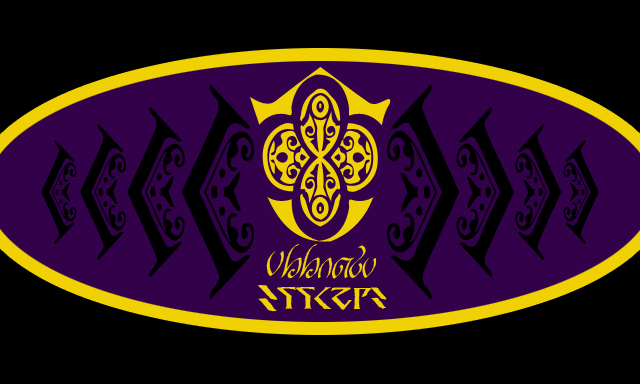
National Map
Demography
- Population: ~75,000,000
- 40% Gnome
- 38% Halfling
- 12% Dwarf
- 6% Elf
- 4% Other
Leadership
- Government: Corporate Republic
- The government of Ellante is overtly run by major corporations that run monopolies on world-wide ventures that may extend from trade all the way to mercenary work. Power is vied for between corporations like feudal houses, but war is exceptionally rare as no one likes to lose an investment as large as living capital (which is to say that is how they see things).
- Power Acquisition: Rising up through the ranks in a corporation or being born into money and buying your way there.
Relations
- Aetoth: Allies, major trading partners
- Amon: Allies, major trading partners
- Diatris: Neutral, seen as inferior and simple-minded zealots
- Kulnaku: Enemies
- Lavoya: Allies, major trading partners
- Ramor: Friends, sparse independent trade
- Thollon: Neutral, minor trading partners
- Vodis: Allies, major trading partners
Economy
- Income:
- Sea-based trade: 40%
- Land-based trade: 25%
- Taxation: 15%
- Banking and Investment: 20%
- Expenses:
- Military: -25%
- Research: -50%
- Public Works: -10%
- Salaries: -15%
Military
- Equipment:
- Melee-Weapon of Choice: SRD:Gnome Hooked Hammer
- Ranged-Weapon of Choice: SRD:Repeating Heavy Crossbow
- Armor of choice: SRD:Breastplate
- Shield of choice: None
- Uniform: Camouflage-painted armor (flat colors only, with)
- Numbers (Standing):
- Infantry (light): 3,000,000
- Infantry (heavy): 2,000,000
- Cavalry (light): 750,000
- Cavalry (heavy): 250,000
- Navy (light): 40,000 ships, 3,000,000 sailors
- Navy (heavy): 10,000 ships, 50,000 sailors
- Special Forces: 350,000 operatives
- Intellegence: 600,000 soldiers
- Espionage: 500,000 agents, 500,000 analysts
- Leadership: 1,000,000 officers
- Total: 12,000,000
- Numbers (potential draftees)
- 35,00,000
Religion
- Garl Glittergold: 40%
- Yondalla: 38%
- Moradin: 12%
- Other: 10%
Culture
- Women's Rights: Women are considered just as capable as men are in most faculties and are generally considered equal. Typically, gnomes don't care for gender politics and consider both genders equal simply because they view gender as something unilaterally irrelevant compared to individual talent.
- Slave-labor: Used to pay off debts as indentured servitude. Drow may be slaves if found guilty of crime.
- Magic: Magic is intensively studied and used wherever convienient. If technology would provide a simpler means of solving a problem then technology would be used instead, the Ellantans prefer to solve problems rather than quibble about legitimacy.
- Education: children between the ages of 10 and 40 go to an academy. The first 15 years are spent exploring what their talents are, and then the second 15 years are spent developing those talents.
- Legal: Laws are enacted by a general council established by the top 13 most dominant corporations in the nation.
Health
- Infant mortality rate: 25%
- Dental health: Outstanding, the best in Oa
- Plague control: Scientists, doctors, and healers are all mobilized into a task force to address the problem.
Kulnaku
- (Col-nah-koo)
- (adj: Kulnakan)
The sworn enemy of Diatris, Kulnaku is the supposed "land of evil". Populated mostly by Drow, thousands of years of genocide inflicted on them by Diatrien raids have caused for their society to become hateful and brooding towards revenge against Diatris. A terribly sad story of a once peaceful people becomming the nightmare they were once thought to be, Kulnaku is imfamous for dealings with devils, demons, dragons, and all other manners of evil creatures, all in the name of exterminating the Diatriens and anyone who stands to defend them. Some drow and other races seek to escape Kulnaku for sanctuary and the few that survive usually end up in Aetoth. Evil festers in Kulnaku, and it has been waiting many years for its chance to strike back at the supposedly "good" nation of Diatris.
National Flag
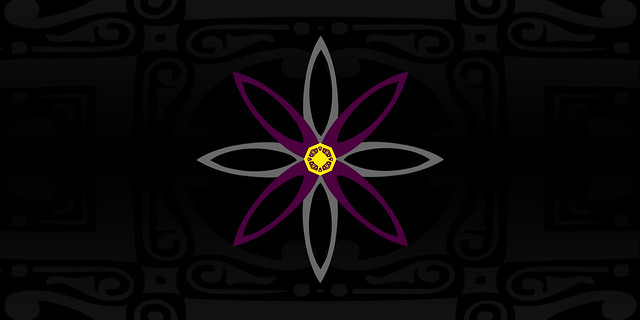
National Map
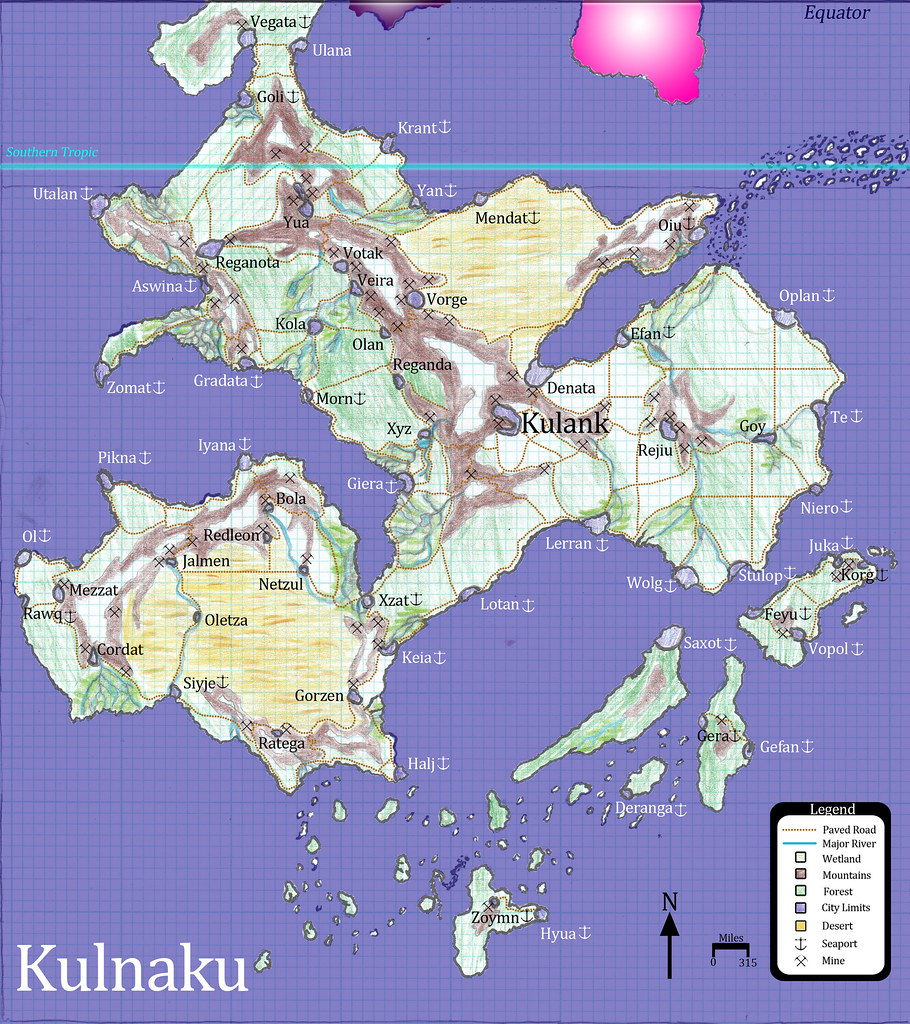
Demography
Leadership
- Government: Monarchy
- Incumbent: Queen Aracha
- Heir Apparent: Princess Scorpaea
Relations
- Aetoth: Enemies
- Amon: Enemies
- Diatris: Sworn enemies
- Ellante: Enemies
- Lavoya: Enemies
- Ramor: Enemies
- Thollon: Enemies
- Vodis: Enemies
Economy
- Income:
- Sea-based trade (Domestic Only): 9%
- Land-based trade (Domestic Only): 1%
- Taxation: 75%
- Banking and Investment: 15%
- Expenses:
- Military: -45%
- Research: -45%
- Public Works: -10%
- Salaries: -0%
Military
- Equipment:
- Melee-Weapon of Choice: Scimitar, Bastard Sword
- Ranged-Weapon of Choice: Composite Longbow
- Armor of choice: Dragon-skin Scale Mail.
- Shield of choice: Cold Steel Tower Shield
- Uniform: Black Armor and helmets with a dark purple flower crest painted above the heart.
- Numbers (Standing):
- Infantry (light): 100,000,000 soldiers
- Infantry (heavy): 50,000,000 soldiers
- Cavalry (light): 40,000,000 soldiers
- Cavalry (heavy): 35,000,000 soldiers
- Navy (light): 400 ships, 100,000 sailors
- Navy (heavy): 350 ships, 70,500 sailors
- Special Forces: 3,000,000 operatives
- Intellegence: 4,500,000 soldiers
- Espionage: 1,500,000 agents, 1,000,000 analysts
- Leadership: 50,000,000 officers
- Total: 285,175,000
- Numbers (potential draftees)
- Everyone Serves in the military as long as they are able.
Religion
- Changes, they tend to offer grand sacrifices to buy the favor of different gods and goddesses depending on the needs of the nation.
Culture
- Women's Rights: Women rule the world. Men are second-class citizens.
- Slave-labor: Anyone who owes you something is your slave. Anyone you capture in combat is your slave. Anyone you dominate is your slave.
- Magic: Magic is needed all the time and is the saving grace for Kulnaku.
- Education: Women receive advanced education in the arts and sciences while men receive enough education to hold a sword and kill some Diatriens before they too die.
- Legal: The queen's word is law.
Health
- Infant mortality rate: 25% (more babies = more soldiers)
- Dental health: Any decent father knows how to identify a dental problem and take care of it asap.
- Plague control: Find the god or goddess responsible for it and offer a sacrifice to have it removed.
Lavoya
- (Luh-voy-uh)
- (adj. Lavoyan)
The Crossroads of the Northern part of the Eastern Continent, Lavoya is a place of cultural splendor and extensive wealth. The best analogy for human comparison would be renaissance Italy, as Lavoya represents an amalgam of Elven, Dwarven, and Gnomish cultures. Instead of tolerance and harmony being emphasized, trade and research are the dominant priorities as Dwarves, Halflings, and Gnomes are the most populous of races in Lavoya. Some of the most brilliant minds study in Lavoya as its central location makes it ideal for the sharing of information and research. However, just across the sea the dreaded land of Kulnaku threatens to invade every day of every year, and so Lavoya is constantly depending on its neighbors for protection in case the unthinkable happens and Kulnaku goes to war with the world once again.
National Flag
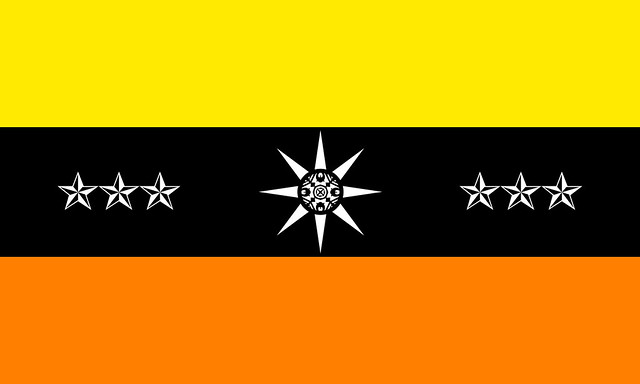
National Map
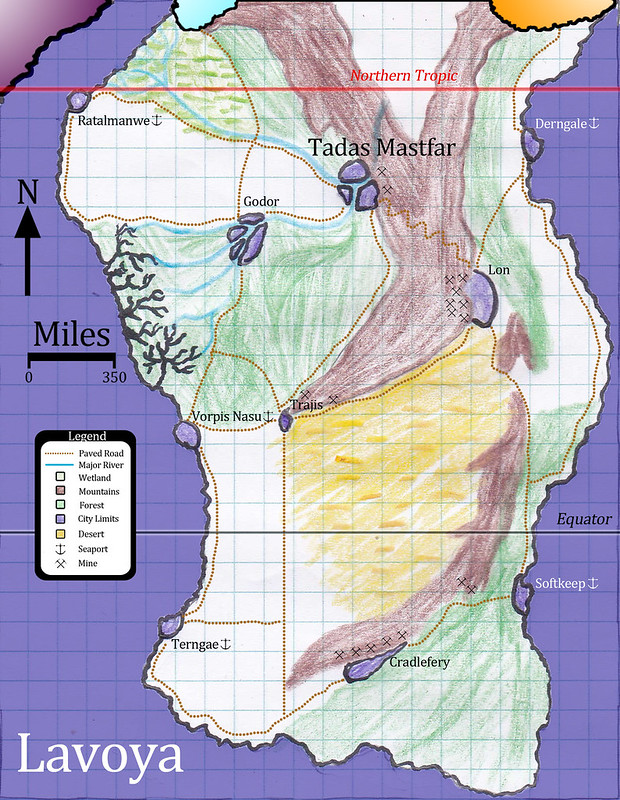
Demography
- Population: ~80,500,000
- Gnome 20%
- Halfling 20%
- Dwarf 20%
- Elf 15%
- Human 10%
- Half-Elf 7%
- Half-Orc 6%
- Other 2%
Leadership
- Government: Republic
- A house of 99 Senators and 1 Administrator meets once a week to discuss matters of state.
- Power Acquisition: Voted by majority vote to be a representative in your home province of Lavoya.
Relations
- Aetoth: Allies, major trading partners
- Amon: Allies, major trading partners
- Diatris: Neutral, wish to be trading partners
- Ellante: Allies, major trading partners
- Kulnaku: Enemies
- Ramor: Friends, sparse independent trade
- Thollon: Friends
- Vodis: Allies, major trading partners
Economy
- Income:
- Sea-based trade: 40%
- Land-based trade: 15%
- Taxation: 5%
- Banking and Investment: 30%
- Tourism: 10%
- Expenses:
- Military: -5%
- Research: -50%
- Public Works: -25%
- Salaries: -20%
Military
- Equipment:
- Melee-Weapon of Choice: Rapier
- Ranged-Weapon of Choice: Light Crossbow
- Armor of choice: Breastplate
- Shield of choice: Light Steel Shield
- Uniform: Arm-Bands with brass badges on them that display the soldier's rank.
- Numbers (Standing):
- Infantry (light): 10,000 soldiers
- Infantry (heavy): 5,000 soldiers
- Cavalry (light): 10,000 soldiers
- Cavalry (heavy): 2,000 soldiers
- Navy (light): 200 ships, 1,000 sailors
- Navy (heavy): 75 ships, 750 sailors
- Special Forces: 500 operatives
- Espionage: 40 agents, 100 analysts
- Leadership: 2,000 officers
- Total: 30,890
- Numbers (potential draftees)
- Lavoya does not have a draft. It has been put to committee to decide whether or not to reinstate one, but there has been no deliberation on the subject as of yet.
Religion
- Secular government.
- Free religion policy.
Culture
- Women's Rights: Women and Men are legally considered and treated equally.
- Slave-labor: Indentured servitude exists between contractually obligated people where one part consisting of one or more people is indebted to the other.
- Magic: Magic is highly accepted and encouraged, so long as it does not harm others.
- Education: Children must attend school until adulthood, then they must join a guild and learn a trade.
- Legal: Each city has its own set of laws and customs depending on the local government's decree.
Health
- Infant mortality rate: 20%
- Dental health: Highly encouraged, especially in minors.
- Plague control: An investigation is commenced by the local government to analyze and contain the outbreak. Once the investigation is complete, a course of action is suggested by the investigators to the local or federal government.
Ramor
- (Ray-more)
- (adj: Ramoran)
The tropical continent of Ramor is home to Oa's widest selection of races. Just about any race can be found living in their sweltering hot but nevertheless beautiful cities. The Ramorans are mostly a peaceful people who are mostly interested in nature and natural beauty instead of war and politics. Usually seen as the daughter nation to Amon, Ramor is a vast continent populated mostly with elves but that majority is only such by a small margin. Being located so close to the vast, uncharted archipelago to the north and east, Ramor is known to have troubles with pirates sailing around their shores. Nevertheless, Ramor is a prosperous and peaceful nation that welcomes outsiders so long as they sign an oath to abide and obey the local laws while they stay. In short, Ramor is the tourist destination of Oa for most travel-interested people as its scenic jungles and gorgeous landscapes are bar none the most amazing in the world.
National Flag

National Map

Demography
- Population: ~40,000,000
- 25% Elves
- 20% UA:Jungle Elves
- 15% Half-Elves
- 11% Other
- 10% Human
- 5% Centaur
- 5% SRD:Sprites—Pixies (Race)
- 5% SRD:Satyrs (Race)
- 5% Gnome
- 5% Halfling
- 2% SRD:Lizardfolk (Race)
- 1% Half-Orcs
- .75% SRD:Elves, Aquatic (Race)
- .25% Drow
Leadership
- Government: Representative Democracy
- A panel of representatives from each city vote on state issues.
- Power Acquisition: Voted as a representative for your province in an election every 10 years.
- The representative acts as a governor for that province for a term of 10 years.
Relations
- Aetoth: Allies, seen as brethren
- Amon: Allies, seen as brethren
- Diatris: Neutral
- Ellante: Allies, major trading partners
- Kulnaku: Enemies
- Lavoya: Allies
- Thollon: Friends, trading partners
- Vodis: Neutral
Economy
- Income:
- Sea-based trade: 25%
- Land-based trade: 5%
- Taxation: 10%
- Banking and Investment: 4%
- Tourism: 56%
- Expenses:
- Military: -25%
- Research: -25%
- Public Works: -25%
- Salaries: -25%
Military
- Equipment:
- Melee-Weapon of Choice: Scimitar
- Ranged-Weapon of Choice: Composite Longbow
- Armor of choice: Scale Mail
- Shield of choice: Light Steel
- Uniform: Dark Green armor, camouflaged.
- Numbers (Standing):
- Infantry (light): 100,000 soldiers
- Infantry (heavy): 50,000 soldiers
- Cavalry (light): 25,000 soldiers
- Cavalry (heavy): 5,000 soldiers
- Navy (light): 130 ships, 102,000 sailors
- Navy (heavy): 70 ships, 35,000 sailors
- Special Forces: 1,750 operatives
- Intellegence: 3,000 soldiers
- Espionage: 870 agents, 300 analysts
- Leadership: 125,000 officers
- Total: 447,920
- Numbers (potential draftees)
- ~30,000,000
Religion
- No State Religion
- Citizens possess the right to worship whatever deity they choose to, so long as doing so does not bring harm to others.
Culture
- Women's Rights: Women are considered equals to males, gender is otherwise seen as yet another aspect of nature.
- Slave-labor: Prohibited.
- Magic: Magic is highly accepted and encouraged, so long as it does not harm others.
- Education: Children must attend school for as long as their parents wish.
- Legal: Each province of Ramor is in charge of its own laws, but there are a small list of core laws that are enforced throughout the nation. These core laws are voted on by the representatives of each province.
Health
- Infant mortality rate: 32%
- Dental health: Available but not usually encouraged.
- Plague control: Ramor is perhaps the most experienced nation in terms of disease and plague. Quarantine is a common tactic followed by magical golems sent in to perform medical procedures at designated clinics. These golems are controlled from afar via scrying magic by Ramor's guild of Medical personnel, who are versed in any and all necessary fields for medical care.
Thollon
- (Th-ol-ahn)
- (adj: Thollon)
Also known as "The Kingdom of the Roaring Sea", Thollon is an ancient human kingdom with a history spanning over 2,000 years. Their royal lineage has almost never been broken, a fact that they are quite proud of. Though most scholars would cast doubt upon this in casual conversation with people they trust secrets to. They are a secular and proud people, looking down on stubborn religious traditions that make no sense, and often mocking their northern neighbor: Diatris for their fervent religious practices. This has led to a few small wars in the past, but by and large Diatris and Thollon stay at peace with one another knowing that taking care and occupying another part of the continent would be a humungous loss on their own fiscal parts.
National Flag

National Map
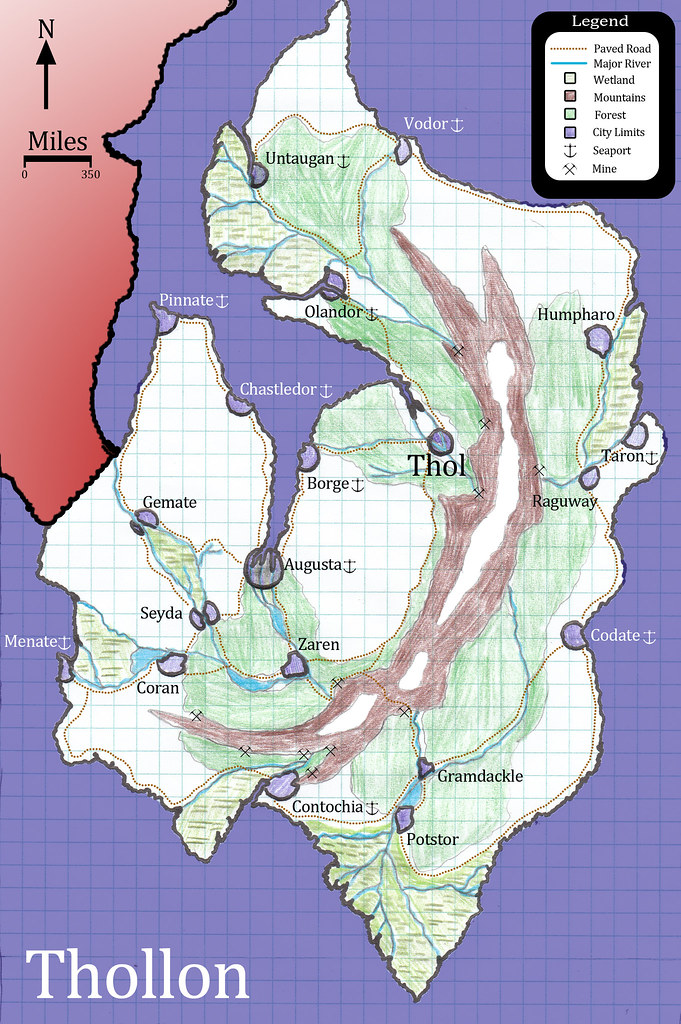
Demography
Leadership
- Government: Monarchy
- Incumbent: King Phillip II
- Heir Apparent: Prince Terone IV
Relations
- Aetoth: Neutral, trading partners
- Amon: Neutral, sparse independent trade
- Diatris: Rivals, currently at peace
- Ellante: Allies, major trading partners
- Kulnaku: Enemies
- Lavoya: Neutral, sparse official trade
- Ramor: Friends, trading partners
- Vodis: Neutral, sparse independent trade
Economy
- Income:
- Sea-based trade: 30%
- Land-based trade: 20%
- Taxation: 45%
- Banking and Investment: 5%
- Expenses:
- Military: -50%
- Research: -25%
- Public Works: -15%
- Salaries: -5%
Military
- Equipment:
- Melee-Weapon of Choice: Longsword
- Ranged-Weapon of Choice: Longbow
- Armor of choice: Chainmail
- Shield of choice: Heavy Steel
- Uniform: dark blue boots, gloves, and an open-faced steel helmet with a dark blue plume.
- Numbers (Standing):
- Infantry (light): 100,000 soldiers
- Infantry (heavy): 50,000 soldiers
- Cavalry (light): 40,000 soldiers
- Cavalry (heavy): 35,000 soldiers
- Navy (light): 40 ships, 10,000 sailors
- Navy (heavy): 35 ships, 7,500 sailors
- Special Forces: 300 operatives
- Intellegence: 450 soldiers
- Espionage: 150 agents, 150 analysts
- Leadership: 50,000 officers
- Total: 293, 550
- Numbers (potential draftees)
- ~10,000,000
Religion
- Secular government
- Religion is not commonly practiced by most people in Thollon. As a back-lash against the fundamentalist theocratic monarchy that prevails in their neighbor to the north: Diatris.
Culture
- Women's Rights: Women are second-class citizens and posess no legal rights whatsoever. They are considered propety of either their spouse or closest-related male relative.
- Slave-labor: Prohibited in private sectors. Can be an indentured servant to the government to pay off taxes or debts.
- Magic: Magic is somewhat accepted but generally looked down upon as strange and unusual.
- Education: Education is handled by private tutors that travel among family households rich enough to hire them.
- Legal: Laws are enacted by royal decree. One is considered guilty until proven innocent. Magistrates travel between regions to hold trials in court circuits. Most are lawful neutral, some are not.
Health
- Infant mortality rate: 45%
- Dental health: non-existant, teeth are removed if they hurt.
- Plague control: the site of the plague is quarantined with all the ill and dead remaining inside, and burnt until it's completely ashen. Anyone attempting to enter a zone is permitted, anyone leaving (for whatever reason) is killed on sight and their corpse is immolated from afar. The course of action varies depending on the size of the population afflicted and what the king decides to do.
Vodis
- (Voh-diss)
- (adj. Vodian)
The homeland of the Dwarves, this mountainous and densely vegetated region of Oa is covered in harsh and intense jungles that have served the Dwarves well over the centuries for their combat training. Living mostly in vast, underground cities that stretch so far into the planet that most people have forgotten some of the deeper, older sections. Nevertheless these older sections of the cities of Vodis are fraught with peril and viciously confusing traps in case in invasion force from Kulnaku ever tried to tunnel their way in. The Dwarves are some of the finest craftsmen in Oa, and the absolute best smiths, gem-cutters, architects, and above all else...brew-masters.
National Emblem

National Map
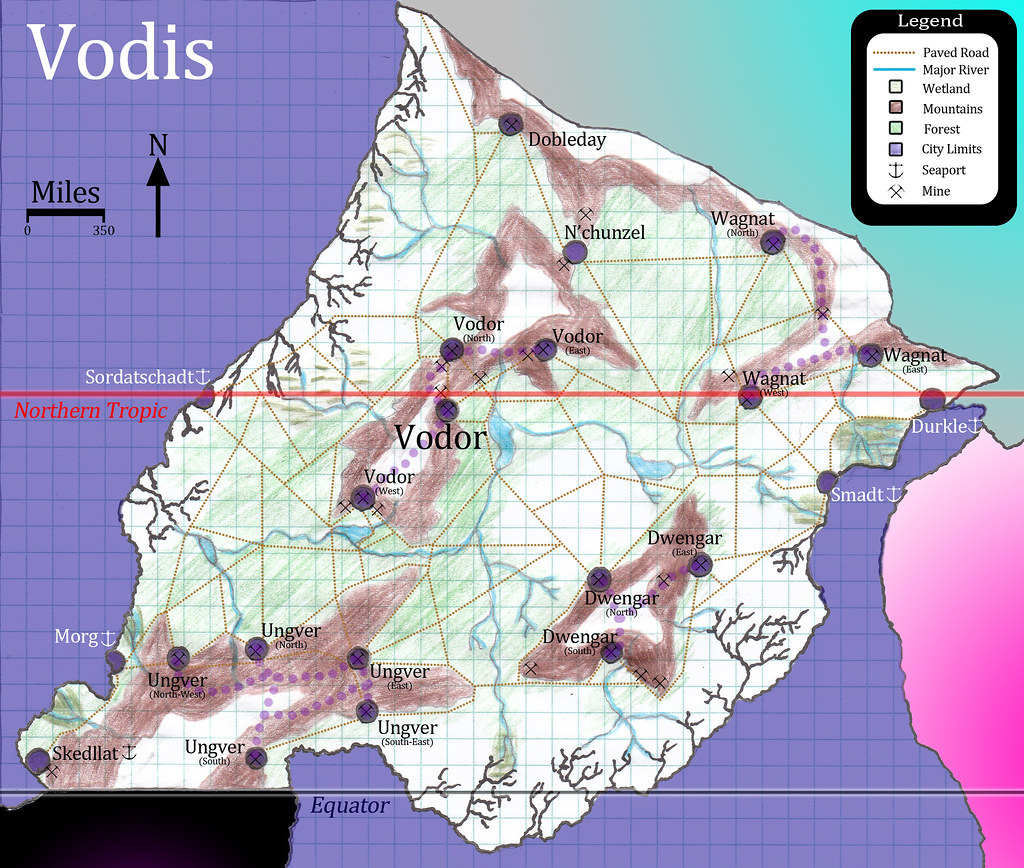
Demography
Female Dwarves & Beards
- The allelle for facial hair in Dwarven women is recessive. Some have beards but most don't.
- Bearded Female: ~25%
- Unbearded Female: ~75%
Leadership
- Government: Monarchy
- Leadership: King Vor CCCLXXIII
- Heir Apparent: Prince Ragavor I
Relations
- Aetoth: Neutral, major trading partners
- Amon: Neutral, major trading partners
- Diatris: Neutral
- Ellante: Allies, major trading partners
- Kulnaku: Enemies
- Lavoya: Allies, major trading partners
- Ramor: Neutral
- Thollon: Neutral, sparse independent trade
Economy
- Income:
- Sea-based trade: 10%
- Land-based trade: 30%
- Taxation: 30%
- Banking and Investment: 30%
- Expenses:
- Military: -25%
- Research: -25%
- Public Works: -40%
- Salaries: -10%
Military
- Equipment:
- Melee-Weapon of Choice: Dwarven Waraxe, Dwarven Urgrosh, Warhammer, Heavy Mace
- Ranged-Weapon of Choice: Light Crossbow, Repeating Heavy Crossbow
- Light Armor of choice: Dwarven Chainmail
- Heavy Armor of choice: Dwarven Full-plate
- Shield of choice: Heavy Steel
- Uniform: Black armor with brass filigree for officers.
- Numbers (Standing):
- Infantry (light): 1,000,000 soldiers
- Infantry (heavy): 500,000 soldiers
- Cavalry (light): 5,000 soldiers
- Cavalry (heavy): 2,500 soldiers
- Navy (light): 10 ships, 5,000 sailors
- Navy (heavy): 50 ships, 25,000 sailors
- Special Forces: 250,000 operatives
- Intelligence: 40,000 soldiers
- Espionage: 100 agents, 50 analysts
- Leadership: 750,000 officers
- Numbers (potential draftees)
- ~350,000,000
Religion
- Moradin: 80%
- Garl Glittergold: 10%
- Yondalla: 7%
- Other: 3%
Culture
- Women's Rights: Women are in charge of the home and representative of their sect of their individual clan and all affairs and decisions relevant to it. Men are in charge of the family, protection, and finance. There isn't much dispute about this division except for it causes most husbands to frequent the local taverns more often.
- Note: If a man's family has at least eight children, he may take a second wife to help assist the first wife. The second wife is part of the family and acts as a sort of Vice-representative to the first wife. Generally, the second wife is usually much younger than the first in case the female dies and usually inherits the matron-status during middle age. The maximum number of wives permitted is still caught up in committee for debate after some 700 years.
- Slave-Labor: Men only, and only if they are in debt to the king or to the head of their clan. Penalty labor for criminals is not considered slavery, technically.
- Magic: Believed to be very, very useful and handy in tough situations. The common idea towards magic is that it's only dangerous to idiots and people who don't know they are idiots.
- Education: Mandatory for all children, separated by gender. Organized into tiers of skill-level, there are 40 in total with 40 being the highest and most difficult. One graduates to the next tier based on ability, not age. By 40 years of age, you are removed from the school and forced into a job if you do not already have one.
- Legal:
- Coded Laws made by Royal decree and Judicial consensus
- Judges hold trials in courthouses in each major city and town.
- Trials function with a Jury of 21 randomly selected jurors, and a judge.
- For murder and capital offenses, there is a tribunal of three judges and three juries of 21.
- One is considered innocent until proven guilty.
- The penalty for Murder and theft of objects worth equal to and over 1000 pp is Death by decapitation.
- The most common penalty is not just incarceration but is also being enlisted to do community service for an extensive amount of time (usually in groups of 2 years)
- Jobs include but are not limited to:
- Sewage duty
- Furnace stoking/cleaning
- Street sweeping
- Trap inspector
- Ventilation maintenance
- Pest control
- Road-building
- Jobs include but are not limited to:
Health
- Infant mortality rate: 25%
- Dental health: moderate.
- Plague control: Doctors are mobilized alongside priests and wizards to handle the plague.
Back to Main Page → 3.5e Homebrew → Campaign Settings